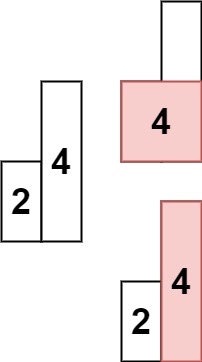Given an array of integers heights representing the histogram's bar height where the width of each bar is 1, return the area of the largest rectangle in the histogram.
Example 1:

Input: heights = [2,1,5,6,2,3] Output: 10 Explanation: The above is a histogram where width of each bar is 1. The largest rectangle is shown in the red area, which has an area = 10 units.
Example 2:

Input: heights = [2,4] Output: 4
Constraints:
1 <= heights.length <= 1050 <= heights[i] <= 104The core challenge of this problem is to find the largest rectangular area that can be formed within the histogram. This problem is significant in various fields such as computer graphics, data visualization, and computational geometry. A common pitfall is to attempt a brute-force solution, which would be inefficient for large inputs.
To solve this problem, we can use a stack-based approach which allows us to efficiently calculate the largest rectangle. The naive solution would involve checking all possible rectangles, which would be too slow (O(n^2) time complexity). Instead, we can use a stack to keep track of the indices of the histogram bars.
The optimized solution involves using a stack to store the indices of the histogram bars. We iterate through the bars, and for each bar, we maintain the stack such that the heights of the bars corresponding to the indices in the stack are in non-decreasing order. When we encounter a bar that is shorter than the bar at the index stored at the top of the stack, we pop the stack and calculate the area of the rectangle with the popped bar as the smallest (or minimum height) bar. This ensures that we calculate the maximum possible area for each bar efficiently.
import java.util.Stack;
public class LargestRectangleInHistogram {
public int largestRectangleArea(int[] heights) {
// Initialize a stack to store indices of histogram bars
Stack<Integer> stack = new Stack<>();
int maxArea = 0;
int n = heights.length;
for (int i = 0; i <= n; i++) {
// Get the current height or 0 if we are at the end
int currentHeight = (i == n) ? 0 : heights[i];
// While the stack is not empty and the current height is less than the height of the bar at the top of the stack
while (!stack.isEmpty() && currentHeight < heights[stack.peek()]) {
// Pop the top of the stack and calculate the area
int height = heights[stack.pop()];
int width = stack.isEmpty() ? i : i - stack.peek() - 1;
maxArea = Math.max(maxArea, height * width);
}
// Push the current index onto the stack
stack.push(i);
}
return maxArea;
}
public static void main(String[] args) {
LargestRectangleInHistogram solution = new LargestRectangleInHistogram();
int[] heights1 = {2, 1, 5, 6, 2, 3};
System.out.println("Largest Rectangle Area: " + solution.largestRectangleArea(heights1)); // Output: 10
int[] heights2 = {2, 4};
System.out.println("Largest Rectangle Area: " + solution.largestRectangleArea(heights2)); // Output: 4
}
}
The time complexity of this approach is O(n) because each bar is pushed and popped from the stack at most once. The space complexity is O(n) due to the stack used to store the indices.
Some potential edge cases include:
Each of these cases is handled by the stack-based approach, ensuring that the maximum area is calculated correctly.
To test the solution comprehensively, consider the following test cases:
When approaching such problems, it is essential to:
Understanding and solving the "Largest Rectangle in Histogram" problem is crucial for developing efficient algorithms. By using a stack-based approach, we can achieve an optimal solution with a time complexity of O(n). Practicing such problems helps in honing problem-solving skills and understanding the application of data structures.
Our interactive tutorials and AI-assisted learning will help you master problem-solving skills and teach you the algorithms to know for coding interviews.
Start Coding for FREE